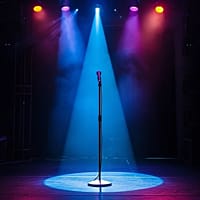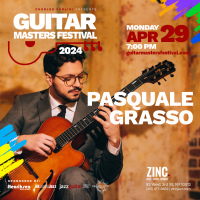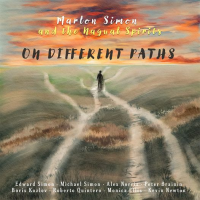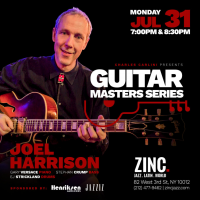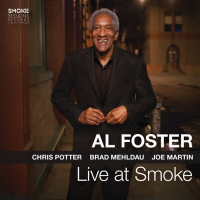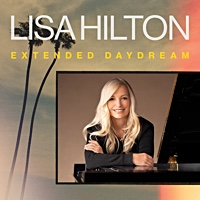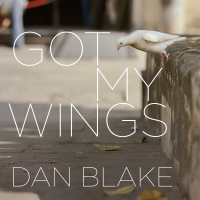Just off the corner of Houston Street and LaGuardia Place, where the West Village meets SoHo, a short flight of stairs below street level, the Zinc Bar may very well be as close in size and spirit to a ‘50s 52nd Street jazz club as one is now likely to ever find in this city. Not much more than a sliver of a room, the Zinc has nevertheless played a large role in keeping the future of the music bright in an area where constantly rising real estate values have all but banished the bohemian aura that once defined the neighborhood.
The Zinc Bar is not a jazz club per se. It’s more than that. The room presents a melting pot of music - African, Brazilian and AfroCuban - along with jazz. But it is the free spirit of jazz that defines the
excitement of all of the sounds that emanate from the crowded space between the bar and the back of the wall that separates the rest rooms from what serves as the bandstand. With a drum kit jammed into the
corner and the piano intruding into the waitress
station, there is barely enough room for a quartet, but on some nights percussionists spill out into the seats and horn players line the lane of the club.
read more
Just off the corner of Houston Street and LaGuardia Place, where the West Village meets SoHo, a short flight of stairs below street level, the Zinc Bar may very well be as close in size and spirit to a ‘50s 52nd Street jazz club as one is now likely to ever find in this city. Not much more than a sliver of a room, the Zinc has nevertheless played a large role in keeping the future of the music bright in an area where constantly rising real estate values have all but banished the bohemian aura that once defined the neighborhood.
The Zinc Bar is not a jazz club per se. It’s more than that. The room presents a melting pot of music - African, Brazilian and AfroCuban - along with jazz. But it is the free spirit of jazz that defines the
excitement of all of the sounds that emanate from the crowded space between the bar and the back of the wall that separates the rest rooms from what serves as the bandstand. With a drum kit jammed into the
corner and the piano intruding into the waitress
station, there is barely enough room for a quartet, but on some nights percussionists spill out into the seats and horn players line the lane of the club.
Unlike many great clubs where the music
unexpectedly takes over and creates a lively scene never envisioned by the management, the Zinc Bar’s success is in no small part the result of the nurturing philosophy of its owners, brother and sister Alex and Kristina Kaye. The two were up-and-coming young professionals climbing the corporate ladder in the early ‘90s, when Alex couldn’t take it any more. “I planned to open an espresso bar with live music - two of my growing passions at the time [the fall of 1993] and stumbled upon the basement on West Houston Street,” he recalls. “It was a run down shop in the front building with leaky pipes and lots of dust, but it had a great feeling. The rent was a thousand dollars a month.”
“When Alex showed me the space on Houston Street,” Kristina says, “I knew in an instant what I wanted to do - open a business with our creative forces, put the love and the effort into something that would have our own signature. I loved the nightlife, so no longer getting up at 6 was perfectly fine for me.” Alex renovated the space with the help of his father. “Within a week we had our first steady performer playing, an Italian vocalist, Carolina Brandes,” he remembers. “She brought in our first drummer, a
fairly obscure cat called ‘El Negro’ [Horacio Hernandez, who would go on to play with Roy Hargrove and Michel Camilo]. With only a snare he really made the gig sizzle and set an extremely high standard for what would have to follow.”
In the club’s early days jams were the norm
during weeknights and the Brazilians took control over the weekends. Around 1994, jazz
entrepreneur/producer Charles Carlini, who was
dating Kristina at the time, became involved. “He booked some really great musicians at the Zinc that fell in love with playing there,” she says proudly. Guitarist Ron Affif “landed” at the Zinc on the
recommendation of Carlini. “His speed and hardbop swing could blow away any of the other guitarists already known to the club,” according to Alex. “He took ‘em all down one after another and so I moved quickly to give him a coveted steady night. Monday nights were born.”
Monday night at the Zinc Bar has become one of the jazz scene’s most swinging institutions. Affif’s trio, from its early incarnation with Ugonna Okegwo and Cecil Brooks, became a rhythm section for an ongoing jam that lured luminaries from all over town. Guitarists in particular were conspicuous in their presence - from veterans George Benson, Herb Ellis, Tal Farlow and Attila Zoller to younger stars like Hiram Bullock, Russell Malone, Mark Whitfield and Peter Bernstein. “What Bradley’s was for jazz piano, the Zinc was for jazz guitar,” Alex says with
understandable pride. When Bradley’s closed the Zinc Bar became something even more, taking over the University Place institution’s role as an after-work hang out for many of the city’s jazz masters.
Tuesday and Wednesdays are the Zinc Bar’s
official “jazz nights” where a variety of mostly young groups have made their mark. Vocalist Claudia Acuña and bassist Richard Bona became famous there and still often grace the room both as performers and
listeners. The list of players who play the place
regularly is too long to recount, but the group Brotherhood that made its debut there last year with Marcus and EJ Strickland, Mike and Bob Rodriguez and Yosvany and Yunior Terry is a good example of the caliber of musicianship that is regularly presented. Thursdays’ Latin Jazz nights have featured Broadway’s Celia Cruz star Xiomara Lugart (as a leader and a member of the mega group Yerba Buena in their early days) as well as at various times Andy and Jerry Gonzalez and have been known to get people up and dancing. Fridays feature exciting African bands often with excellent jazz soloists. Saturday nights, sultry songstress Marianni sings soft and smooth bossa nova, while on Sundays pianist Cindinho Teixeira hosts a revolving cast of guest vocalists and percussionists that join his hard swinging samba jazz.
No matter what the night, you can count on some of the city’s best jazz players stopping by - maybe just to listen to the band, but perhaps to jump up on stage and share in the joy.
~ Russ Musto
[email protected]
[email protected]
[email protected]
[email protected]
[email protected]
->
show less

